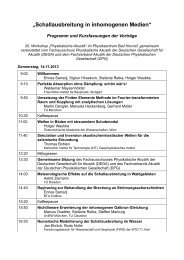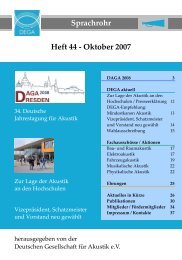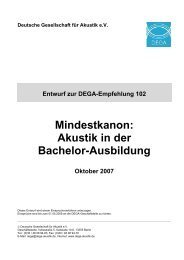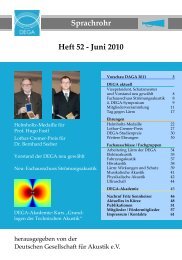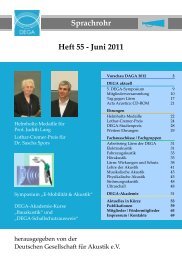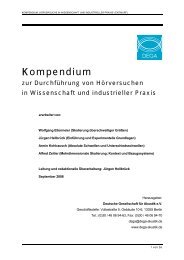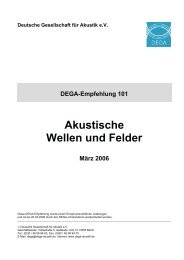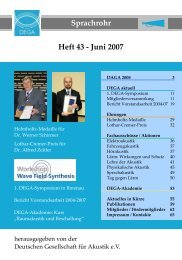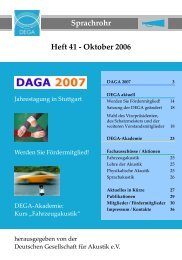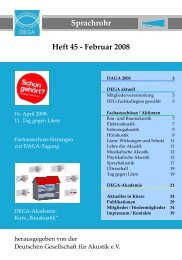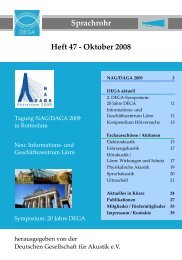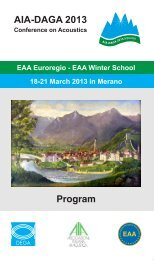- Seite 1 und 2:
PROGRAMMDEGA
- Seite 4 und 5:
2 DAGA 2012 ProgrammUmgebungslärm,
- Seite 6 und 7:
4 DAGA 2012 ProgrammMontag, 19. Mä
- Seite 8 und 9:
6 DAGA 2012 ProgrammDienstag, 20. M
- Seite 10 und 11:
8 DAGA 2012 ProgrammDienstag, 20. M
- Seite 12 und 13:
10 DAGA 2012 ProgrammMittwoch, 21.
- Seite 14 und 15:
12 DAGA 2012 ProgrammMittwoch, 21.
- Seite 16 und 17:
14 DAGA 2012 ProgrammDonnerstag, 22
- Seite 18 und 19:
16 DAGA 2012 ProgrammDonnerstag, 22
- Seite 20 und 21:
18 DAGA 2012 ProgrammGrußwort der
- Seite 22 und 23:
20 DAGA 2012 ProgrammHinweise zur T
- Seite 24 und 25:
22 DAGA 2012 Programmauf den Seiten
- Seite 26 und 27:
24 DAGA 2012 ProgrammVortragende we
- Seite 28 und 29:
26 DAGA 2012 Programm• Gold-Spons
- Seite 30 und 31:
28 DAGA 2012 ProgrammStellenanzeige
- Seite 32 und 33:
30 DAGA 2012 Programm• Mittwoch,
- Seite 34 und 35:
32 DAGA 2012 Programmin der Mensa g
- Seite 36 und 37:
34 DAGA 2012 ProgrammIm Bereich (I
- Seite 38 und 39:
36 DAGA 2012 ProgrammHotels und Tou
- Seite 40 und 41:
38 DAGA 2012 ProgrammPreise der DEG
- Seite 42 und 43:
40 DAGA 2012 ProgrammPlenarvorträg
- Seite 44 und 45:
42 DAGA 2012 ProgrammEntwicklungspr
- Seite 46 und 47:
44 DAGA 2012 ProgrammMo. 13:35germa
- Seite 48 und 49:
46 DAGA 2012 ProgrammMo. 15:10germa
- Seite 50 und 51:
48 DAGA 2012 ProgrammVorkolloquium
- Seite 52 und 53:
50 DAGA 2012 ProgrammMo. 14:25 heli
- Seite 54 und 55:
52 DAGA 2012 ProgrammGrundgleichung
- Seite 56 und 57:
54 DAGA 2012 ProgrammMo. 13:35 tita
- Seite 58 und 59:
56 DAGA 2012 ProgrammMo. 15:10 tita
- Seite 60 und 61:
58 DAGA 2012 ProgrammFachvorträge
- Seite 62 und 63:
60 DAGA 2012 Programmauf einen skal
- Seite 64 und 65:
62 DAGA 2012 ProgrammSitzung „E-M
- Seite 66 und 67:
64 DAGA 2012 ProgrammSitzung „Ger
- Seite 68 und 69:
66 DAGA 2012 ProgrammDienstag (bis
- Seite 70 und 71:
68 DAGA 2012 ProgrammDi. 15:40 Spec
- Seite 72 und 73:
70 DAGA 2012 ProgrammDi. 17:20 Spec
- Seite 74 und 75:
72 DAGA 2012 ProgrammSitzung „Bau
- Seite 76 und 77:
74 DAGA 2012 ProgrammDi. 15:15 Spec
- Seite 78 und 79:
76 DAGA 2012 Programmdem komplexen
- Seite 80 und 81:
78 DAGA 2012 Programmmit Hilfe von
- Seite 82 und 83:
80 DAGA 2012 ProgrammDienstag (bis
- Seite 84 und 85:
82 DAGA 2012 ProgrammSchallfeldzerl
- Seite 86 und 87:
84 DAGA 2012 Programmund instantan
- Seite 88 und 89:
86 DAGA 2012 ProgrammSitzung „Num
- Seite 90 und 91:
88 DAGA 2012 Programmnumerischen Ak
- Seite 92 und 93:
90 DAGA 2012 ProgrammDi. 17:20 vana
- Seite 94 und 95:
92 DAGA 2012 Programm∂ np + δ∂
- Seite 96 und 97:
94 DAGA 2012 ProgrammDi. 14:25 tita
- Seite 98 und 99:
96 DAGA 2012 Programmvorwärtsgesic
- Seite 100 und 101:
98 DAGA 2012 Programmdie Möglichke
- Seite 102 und 103:
100 DAGA 2012 ProgrammDi. 14:25 pal
- Seite 104 und 105:
102 DAGA 2012 Programmwerden Daten
- Seite 106 und 107:
104 DAGA 2012 ProgrammDi. 14:50 aur
- Seite 108 und 109:
106 DAGA 2012 ProgrammDi. 16:30 aur
- Seite 110 und 111:
108 DAGA 2012 Programmthreshold and
- Seite 112 und 113:
110 DAGA 2012 ProgrammIm Beitrag we
- Seite 114 und 115:
112 DAGA 2012 ProgrammDi. 15:15 has
- Seite 116 und 117:
114 DAGA 2012 ProgrammDienstag (bis
- Seite 118 und 119:
116 DAGA 2012 ProgrammAudiosignalen
- Seite 120 und 121:
118 DAGA 2012 Programmwichtige Roll
- Seite 122 und 123:
120 DAGA 2012 ProgrammDi. 17:45 ger
- Seite 124 und 125:
122 DAGA 2012 ProgrammRecognition (
- Seite 126 und 127:
124 DAGA 2012 ProgrammDi. 16:30 rad
- Seite 128 und 129:
126 DAGA 2012 ProgrammThe resulting
- Seite 130 und 131:
128 DAGA 2012 ProgrammSprachmerkmal
- Seite 132 und 133:
130 DAGA 2012 ProgrammDi. 15:15 neo
- Seite 134 und 135:
132 DAGA 2012 Programmverwendeten c
- Seite 136 und 137:
134 DAGA 2012 Programmwas built to
- Seite 138 und 139:
136 DAGA 2012 ProgrammDi. 15:15 hel
- Seite 140 und 141:
138 DAGA 2012 Programmder Akustikso
- Seite 142 und 143:
140 DAGA 2012 ProgrammMi. 9:20 Spec
- Seite 144 und 145:
142 DAGA 2012 ProgrammAuswertung de
- Seite 146 und 147:
144 DAGA 2012 ProgrammDazu wird ein
- Seite 148 und 149:
146 DAGA 2012 Programmauch die Krä
- Seite 150 und 151:
148 DAGA 2012 ProgrammMittwoch (ab
- Seite 152 und 153:
150 DAGA 2012 Programmeinen faserve
- Seite 154 und 155:
152 DAGA 2012 Programmüber kleine
- Seite 156 und 157:
154 DAGA 2012 ProgrammMi. 16:30 Spe
- Seite 158 und 159:
156 DAGA 2012 Programmsich auch auf
- Seite 160 und 161:
158 DAGA 2012 Programmder Flankenü
- Seite 162 und 163:
160 DAGA 2012 Programmzum Körpersc
- Seite 164 und 165:
162 DAGA 2012 ProgrammMi. 15:15 Spe
- Seite 166 und 167:
164 DAGA 2012 ProgrammWohnen” deu
- Seite 168 und 169:
166 DAGA 2012 ProgrammSitzung „Vi
- Seite 170 und 171:
168 DAGA 2012 ProgrammMi. 9:45 chro
- Seite 172 und 173:
170 DAGA 2012 ProgrammMi. 14:50 chr
- Seite 174 und 175:
172 DAGA 2012 Programmentwickelten
- Seite 176 und 177:
174 DAGA 2012 Programmund der steer
- Seite 178 und 179:
176 DAGA 2012 ProgrammMi. 8:55 vana
- Seite 180 und 181:
178 DAGA 2012 ProgrammMi. 10:10 van
- Seite 182 und 183: 180 DAGA 2012 Programmund Seefahrze
- Seite 184 und 185: 182 DAGA 2012 Programmresults. Base
- Seite 186 und 187: 184 DAGA 2012 ProgrammMi. 18:10 van
- Seite 188 und 189: 186 DAGA 2012 ProgrammSitzung „L
- Seite 190 und 191: 188 DAGA 2012 ProgrammUm Veränderu
- Seite 192 und 193: 190 DAGA 2012 ProgrammFür solche A
- Seite 194 und 195: 192 DAGA 2012 Programmund Verarbeit
- Seite 196 und 197: 194 DAGA 2012 Programmdistinkten te
- Seite 198 und 199: 196 DAGA 2012 Programmwenn verschie
- Seite 200 und 201: 198 DAGA 2012 ProgrammMi. 10:10 pal
- Seite 202 und 203: 200 DAGA 2012 ProgrammDas alte Roll
- Seite 204 und 205: 202 DAGA 2012 ProgrammMi. 16:55 pal
- Seite 206 und 207: 204 DAGA 2012 ProgrammIm Vortrag we
- Seite 208 und 209: 206 DAGA 2012 ProgrammMi. 9:45 auru
- Seite 210 und 211: 208 DAGA 2012 Programmmasking varie
- Seite 212 und 213: 210 DAGA 2012 ProgrammMi. 16:30 aur
- Seite 214 und 215: 212 DAGA 2012 Programmdieser Vorher
- Seite 216 und 217: 214 DAGA 2012 ProgrammMi. 9:20 hass
- Seite 218 und 219: 216 DAGA 2012 ProgrammIn dieser Arb
- Seite 220 und 221: 218 DAGA 2012 Programmcompute the d
- Seite 222 und 223: 220 DAGA 2012 ProgrammMi. 17:45 has
- Seite 224 und 225: 222 DAGA 2012 Programman automatic
- Seite 226 und 227: 224 DAGA 2012 ProgrammMi. 9:45 germ
- Seite 228 und 229: 226 DAGA 2012 Programmkonnte die Fu
- Seite 230 und 231: 228 DAGA 2012 ProgrammMi. 16:30 ger
- Seite 234 und 235: 232 DAGA 2012 ProgrammMi. 10:10 rad
- Seite 236 und 237: 234 DAGA 2012 Programmder freien Sc
- Seite 238 und 239: 236 DAGA 2012 Programmder Grundglei
- Seite 240 und 241: 238 DAGA 2012 Programmnach drei Jah
- Seite 242 und 243: 240 DAGA 2012 Programmand noise dom
- Seite 244 und 245: 242 DAGA 2012 Programmder Beitrag m
- Seite 246 und 247: 244 DAGA 2012 ProgrammSitzung „Au
- Seite 248 und 249: 246 DAGA 2012 ProgrammMi. 17:45 neo
- Seite 250 und 251: 248 DAGA 2012 ProgrammMi. 8:55 heli
- Seite 252 und 253: 250 DAGA 2012 ProgrammDie Schall 03
- Seite 254 und 255: 252 DAGA 2012 ProgrammLärmreduktio
- Seite 256 und 257: 254 DAGA 2012 Programmrealer Messwe
- Seite 258 und 259: 256 DAGA 2012 ProgrammMittwoch (ab
- Seite 260 und 261: 258 DAGA 2012 ProgrammSitzung „Me
- Seite 262 und 263: 260 DAGA 2012 Programmuntersucht wu
- Seite 264 und 265: 262 DAGA 2012 ProgrammFachvorträge
- Seite 266 und 267: 264 DAGA 2012 Programmbieten Kopfh
- Seite 268 und 269: 266 DAGA 2012 Programmsich eine vol
- Seite 270 und 271: 268 DAGA 2012 ProgrammDo. 9:20 Spec
- Seite 272 und 273: 270 DAGA 2012 ProgrammDo. 14:25 Spe
- Seite 274 und 275: 272 DAGA 2012 ProgrammDo. 16:05 Spe
- Seite 276 und 277: 274 DAGA 2012 Programmein zusätzli
- Seite 278 und 279: 276 DAGA 2012 Programmvorausberechn
- Seite 280 und 281: 278 DAGA 2012 ProgrammDo. 15:40 Spe
- Seite 282 und 283:
280 DAGA 2012 ProgrammSitzung „St
- Seite 284 und 285:
282 DAGA 2012 Programmauf Finite-El
- Seite 286 und 287:
284 DAGA 2012 Programmsimuliert, wo
- Seite 288 und 289:
286 DAGA 2012 ProgrammDo. 16:30 chr
- Seite 290 und 291:
288 DAGA 2012 Programmist eine Mass
- Seite 292 und 293:
290 DAGA 2012 Programmas lumbar spi
- Seite 294 und 295:
292 DAGA 2012 Programmder Luftultra
- Seite 296 und 297:
294 DAGA 2012 ProgrammDo. 10:10 tit
- Seite 298 und 299:
296 DAGA 2012 ProgrammDo. 14:50 tit
- Seite 300 und 301:
298 DAGA 2012 ProgrammDo. 16:30 tit
- Seite 302 und 303:
300 DAGA 2012 Programmvon der Baust
- Seite 304 und 305:
302 DAGA 2012 ProgrammDo. 14:25 pal
- Seite 306 und 307:
304 DAGA 2012 ProgrammDo. 8:55 auru
- Seite 308 und 309:
306 DAGA 2012 ProgrammSitzung „L
- Seite 310 und 311:
308 DAGA 2012 ProgrammDo. 15:40 aur
- Seite 312 und 313:
310 DAGA 2012 Programmarbitrary spe
- Seite 314 und 315:
312 DAGA 2012 ProgrammDo. 10:10 has
- Seite 316 und 317:
314 DAGA 2012 ProgrammDo. 15:15 has
- Seite 318 und 319:
316 DAGA 2012 Programmaspect in the
- Seite 320 und 321:
318 DAGA 2012 Programmauf den Ablau
- Seite 322 und 323:
320 DAGA 2012 Programmsources of no
- Seite 324 und 325:
322 DAGA 2012 ProgrammTilger zur Sc
- Seite 326 und 327:
324 DAGA 2012 Programmzu gewährlei
- Seite 328 und 329:
326 DAGA 2012 ProgrammDo. 15:40 rad
- Seite 330 und 331:
328 DAGA 2012 ProgrammSitzung „Au
- Seite 332 und 333:
330 DAGA 2012 ProgrammWahrnehmung d
- Seite 334 und 335:
332 DAGA 2012 Programmremarkable nu
- Seite 336 und 337:
334 DAGA 2012 Programmby applying a
- Seite 338 und 339:
336 DAGA 2012 Programmim Arbeitsged
- Seite 340 und 341:
338 DAGA 2012 Programmund Auralisie
- Seite 342 und 343:
340 DAGA 2012 Programm”Traditione
- Seite 344 und 345:
2348 DAGA 2012 ProgrammEbene 1 (Ple
- Seite 346 und 347:
350 DAGA 2012 ProgrammEbene 3 (Vort
- Seite 348 und 349:
352 DAGA 2012 ProgrammMöglichkeite
- Seite 350 und 351:
354 DAGA 2012 ProgrammAnreise mit
- Seite 352 und 353:
356 DAGA 2012 ProgrammBrand, T. . .
- Seite 354 und 355:
358 DAGA 2012 ProgrammGrothe,T. ...
- Seite 356 und 357:
360 DAGA 2012 ProgrammLeistner,P. .
- Seite 358 und 359:
362 DAGA 2012 ProgrammRafaely,B. ..
- Seite 360 und 361:
364 DAGA 2012 ProgrammTessendorf, B
- Seite 362 und 363:
366 DAGA 2012 ProgrammSitzungen wä



